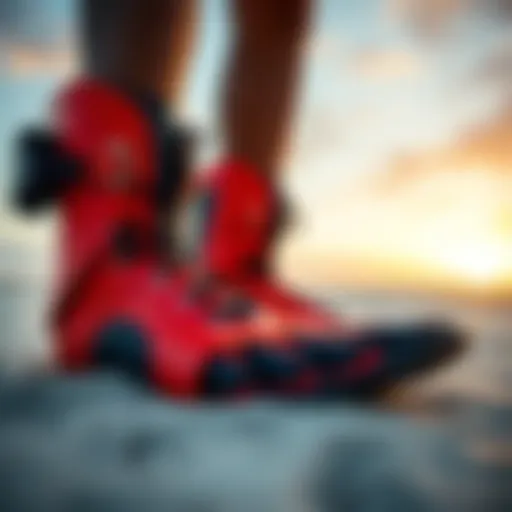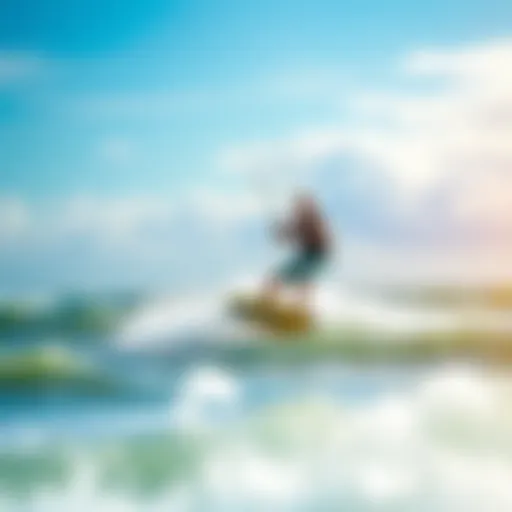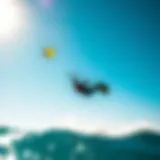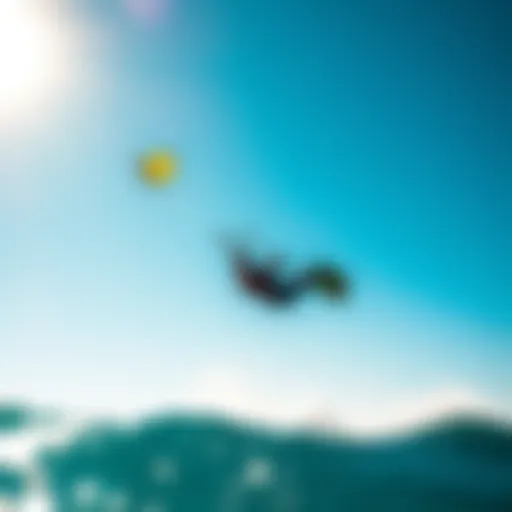Kite Surfing in Hawaii: Dynamics and Culture
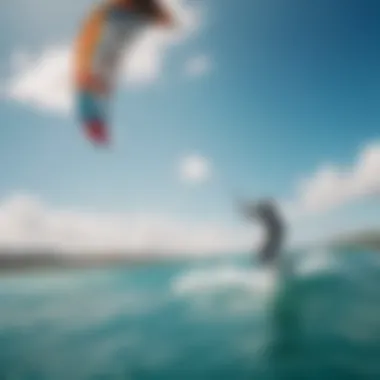

Intro
Kite surfing, or kiteboarding as it's also known, is more than just a sport; it's a thrilling testament to human ingenuity and a celebration of nature's wonders. In Hawaii, where the skies dance with colorful kites and the oceans beckon with perfect waves, kite surfing takes on a unique character that reflects both the stunning beauty and rich cultural heritage of the islands.
From the consistent trade winds that sweep across the coastline to the diverse range of geographical features, Hawaii provides an exquisite backdrop for both seasoned pros and eager novices. This article dives into the heart of kite surfing in Hawaii, shedding light on the essential gear, effective techniques, safety measures, and the vibrant community that breathes life into this dynamic sport.
Through this exploration, we will aim to provide kiteboarders, instructors, travelers, adventurers, and hobbyists with a comprehensive resource, offering insights that enhance both their understanding and appreciation of the sport. Whether you're seeking the sheer thrill of the ride or looking to bond with the local culture, the journey through these pages will illuminate the many facets of kite surfing in Hawaii.
Preface to Kite Surfing in Hawaii
Kite surfing in Hawaii exists at the intersection of thrilling adventure and serene natural beauty. It isn't just about harnessing the wind to glide over crystalline waves; it's about embracing the spirit of the islands, connecting with their vibrant culture, and pushing personal boundaries. The allure of this sport resides not merely in its adrenaline-fueled action but also in the unique experiences it offers, framed by the breathtaking landscapes that Hawaii is renowned for.
The Importance of Kite Surfing
This sport has carved out a significant niche for itself within Hawaii's outdoor activities. For enthusiasts and newcomers alike, understanding the intricacies and nuances of kite surfing is essential, especially in a setting as dynamic as Hawaii. The islands provide a rich canvas of conditions that can either enhance or challenge the kite surfing experience. Knowledge of these aspects can make the difference between a delightful session and a rocky ride.
Kite surfing is not only a pursuit of sport but also a thriving community practice. Interaction among kiteboarders fosters connections that span beyond the beach, nurturing friendships and mutual support among practitioners. For vacationers, Hawaii presents an unparalleled opportunity to engage in this sport, blending leisure with an active lifestyle.
Benefits of Kite Surfing
- Physical Fitness: Kite surfing is a full-body workout that improves strength, balance, and coordination. It transforms the ocean into an open-air gym.
- Mental Health: The exhilaration of gliding over water, coupled with the calming backdrop of the ocean, provides an ideal environment for mental rejuvenation.
- Cultural Immersion: For those visiting, participating in kite surfing immerses individuals in the local culture—interacting with instructors, joining community events, and experiencing traditions firsthand.
- Adventure and Learning: Each session offers opportunities for learning. From mastering new tricks to understanding weather patterns, every outing provides an avenue for personal growth and adventure.
Considerations for Newcomers
For those new to kite surfing, the first step is understanding local regulations and safety protocols, as well as choosing the right spot to start honing their skills. Kite surfing in Hawaii is as much about respect for the environment and community as it is about the sport itself.
"Kite surfing is not just about riding the waves; it’s aboutrespecting the ocean and its rhythms."
From learning to handle the kite to navigating the waves, beginners can expect to spend time both on and off the water to truly master the art. The diversity of the islands means that different areas might cater better to various skill levels, which is an important consideration for planning one’s kite surfing journey.
Geographical Features of Hawaii
When embarking on an adventure in kite surfing, understanding the geographical features of Hawaii proves to be paramount. It's not just about catching the wind and waves but also about how these natural elements align with the specific islands’ topographies. Each Hawaiian island basks in its unique set of features that not only shape the surfing experience but can also pose distinct challenges and offer unique opportunities.
Island-Specific Conditions
In Hawaii, each isle presents a distinct playground for kite surfers. For instance, Oahu's North Shore is famed for its large waves and robust wind patterns, making it a mecca for those who crave high-octane sessions. The combination of shallow lagoons and deeper waters creates varying conditions, permitting both learning and advanced maneuvers. Conversely, the beaches on the windward side of Maui are often buffered by trade winds, which are ideal for both beginners and seasoned surfers.
Further south on the Big Island, the lava rocks form a stark contrast against the sandy beaches, dictating a different approach to safety. Ensuring that you know where to launch and land your kite is vital in these rugged terrains. Each island's idiosyncratic features essentially craft a tailored kite surfing experience, enhancing not just the sport but the very essence of adventure in Hawaii.
Wind Patterns and Ocean Currents
Understanding the interplay of wind patterns and ocean currents in Hawaii is akin to decrypting a puzzle that can significantly influence your kite surfing escapade. The consistent trade winds, prevalent from around April to October, often average between 10 to 25 knots, creating an exhilarating environment for both leisure and competition. These winds serve as the lifeblood for kite surfers, ensuring good sessions almost every day in peak seasons.
Ocean currents further accentuate these wind patterns. Certain spots, such as the shores of Maui, experience unique currents that can either propel surfers forward or impede their progress depending on the time of day and tidal changes. Surfing in harmony with these natural forces is pivotal not just for performance but for safety. Awareness of how low and high tides can alter conditions helps kite surfers anticipate the best times to ride the waves.
Accessibility and Terrain
Accessibility plays a crucial role in choosing a kite surfing destination. Hawaii boasts a wealth of excellent launch sites, but not all spots are easily reachable or user-friendly for newcomers. Most popular beaches, such as Kalama Beach Park in Maui, provide convenient access alongside amenities like restrooms and equipment rentals. However, many hidden gems might require a little more effort to discover, often rewarding those who venture off the beaten path with fewer crowds and pristine conditions.
Terrain varies wildly across the islands, affecting not just access but also the kite surfing experience. Sandy beaches like Kahana Bay on Oahu offer gentle launches, but rocky shores can complicate matters for those unfamiliar with the landscape. Sharp rocks or coral reefs may lurk beneath the waves in some locations, necessitating proper awareness and preparation to avoid accidents.
"Navigating Hawaii’s kite surfing landscape is an adventure within itself. Each detail, be it the gentle breeze or the rocky shore, shapes the thrill and challenge of riding these majestic waters."
By honing in on these geographical intricacies, kite surfers can optimize their experience, if they know the lay of the land and sea. Whether you're an adventurer seeking adrenaline or a hobbyist looking for peaceful rides, Hawaii's geographical gems are sure to inspire.
Climate and Weather Considerations
Kite surfing is closely tied to the natural elements, making climate and weather considerations pivotal for anyone venturing into this thrilling sport. In Hawaii, with its unique geographical layout, the interplay between wind, temperature, and humidity creates the ideal conditions for kite surfing. Understanding these elements not only enhances your experience but also contributes to safety during sessions.
Seasonality of Winds
The winds in Hawaii are like a fickle friend; they come and go throughout the year, influenced by seasonal changes. Generally, the northeast trade winds dominate the island’s weather patterns, particularly from May to September. These winds can gust around 15 to 25 knots, providing solid conditions for kite surfing.
In winter months, notably from October to April, conditions may shift with more variable winds. Surfers might find themselves stuck waiting for the right breeze, which can be unpredictable. It’s important to keep tabs on local forecasts and trends. Local kite surfers swear by apps that provide real-time wind readings—these tools can prove invaluable.
Temperature Variations and Humidity
Another factor that plays a significant role in kite surfing is temperature and humidity. Hawaii’s climate is typically warm year-round, with average temperatures hovering between 70°F to 85°F. However, humidity can impact comfort levels, especially during peak sun hours. It can feel sticky, and the sun can be relentless, making it essential to stay hydrated and use plenty of sunscreen.
Furthermore, the temperature of the water is quite inviting, often ranging from 75°F to 80°F. This means that many kite surfers can enjoy sessions without the need for wetsuits or restrictive gear, allowing for more freedom of movement while riding the waves.
Best Times for Kite Surfing
So, when’s the best time to hit the water? In Hawaii, it’s generally understood that the ideal time for kite surfing is during the late spring to early fall months. July and August are favorites among kiteboarders due to the consistent winds and warm weather. However, it’s important to note that various locations on the islands may offer distinct experiences. For instance:


- Oahu’s North Shore can experience stronger winds in the winter, appealing to more advanced surfers.
- Maui’s Kite Beach typically has a shorter window, so capturing that perfect summer breeze is crucial.
- Kona Coast on the Big Island might offer unique wind conditions, especially during mornings and evenings.
"Picking the right wind season can make or break your kite surfing experience. Always check local conditions to tailor your plans accordingly."
Balancing the interplay between seasonal wind patterns, temperature variations, and the best times to surf indeed shapes the kite surfing experience in Hawaii. Understanding these aspects allows kiteboarders, from amateurs to seasoned pros, to maximize their time on the water while ensuring they stay safe in the often-changing Hawaiian environment.
Essential Equipment for Kite Surfing
The essence of kite surfing stems from the right gear tailored to meet both individual needs and the demands of the environment. Selecting appropriate equipment not only enhances performance but also directly relates to safety and enjoyment while riding the waves. In Hawaii, where conditions can change swiftly, having the correct kite and gear specialized for local weather patterns is crucial. By understanding the various components involved, kite surfers can elevate their experience and navigate challenges more effectively.
Kites: Types and Specifications
Choosing the right kite is the cornerstone of kite surfing. Kites come in different shapes and sizes, each affecting how they interact with the wind and water. Common types include:
- C-Kites: Known for their excellent performance in freestyle and competition settings, these kites offer strong pull and precision steering.
- Bow Kites: These are versatile and stable, ideal for beginners due to their predictable flight and lifting abilities.
- Delta Kites: Perfect for light wind conditions, these provide great upwind capabilities and are suitable for various skill levels.
- Hybrid Kites: A blend of the above types, hybrids offer flexibility and can adapt to multiple riding styles.
When selecting a kite, factors such as wind range, material quality, and line length should be considered. Opting for well-constructed kites ensures durability and responsiveness in changing weather conditions, critical for kite surfers in Hawaii's dynamic climate.
Boards: Selecting the Right Fit
The next component is the board, which varies in size, shape, and material. Each choice affects maneuverability, speed, and stability.
- Directional Boards: Designed for experienced surfers wanting that surfboard feel. They are longer and offer a different style of riding.
- Twintip Boards: Popular among beginners and freestyle enthusiasts, these boards allow for riding in both directions, enhancing versatility.
- Foil Boards: A newer option, they create lift above the water, providing a unique sensation and enabling riding in light winds.
When picking a board, consider your current skill level, rider weight, and the type of riding you intend to do. A well-matched board will make the learning curve less steep and the experience more enjoyable.
Harnesses and Safety Gear
The importance of safety in kite surfing cannot be overstated. The harness connects the surfer to the kite, ensuring control while distributing forces evenly across the body. Choosing a well-fitting harness is critical, as it can prevent discomfort and enhance control during rides.
Various harness types include:
- Waist Harnesses: These are preferred for freestyle and wave riding, providing flexibility and freedom of movement.
- Seat Harnesses: Ideal for beginners, they offer more support and are easier to use in heavy conditions.
Beyond harnesses, safety gear plays a crucial role:
- Impact Vest: Protects the body from falls, which can be harsh, especially in turbulent water.
- Helmets: Needed for added head protection while tackling waves and jumps.
- Leashes: Helps maintain connection with the board, reducing the risk of losing it in crashes.
"Good gear doesn't just protect you; it takes your performance to new heights."
Popular Kite Surfing Locations in Hawaii
Kite surfing in Hawaii is as much about the thrill of the sport as it is about the breathtaking backdrops that accompany these thrilling rides. When venturing into the world of kite surfing, the choice of location can make or break one’s experience. Each spot offers unique wind conditions, wave patterns, and ambient beauty, which are essential for kiteboarders spanning from beginners to seasoned pros.
Exploring these popular locations not only highlights the diverse surfing culture within Hawaii but also guides kite surfers towards the best conditions for their skill levels and ambitions. These spots are essential laboratories for mastering techniques, sharing tips, and forming connections with fellow enthusiasts.
"Hawaii offers not just a playground for kite surfers, but a community enriched by its water and winds."
North Shore of Oahu
The North Shore of Oahu, known for its iconic big waves, also features some exploring spots that are great for kite surfing. While it may come as a surprise to some, the right spices of wind and tide can easily convert this area into a kite surfer's paradise. Areas like Mokuleia, often overlooked, provide expansive beaches and consistent trade winds which can lead to fantastic rides.
The picturesque landscape includes golden sands and clear waters. It's ideal for those looking to practice their skills over a more forgiving surf, while still being surrounded by stunning scenery. The vibrant community and varied skill levels create an inviting atmosphere for kite surfers of all shades.
Maui’s Kite Beach
Maui’s Kite Beach is world-renowned and highly regarded among both amateurs and experienced kite surfers. Located in the alluring Ho’okipa Beach Park, this site features strong wind conditions which provide consistent opportunities to catch some air. The backdrop of lush greenery meeting the azure sea elevates the entire experience.
This beach also caters to competitions, drawing kite surfers from all corners to showcase their skills. With facilities available for rentals and lessons, even those new to the sport can dive right in. Consequently, Maui not only becomes a haven for the experienced but serves as a welcoming gateway for beginners eager to learn the ropes.
Kona Coast and Its Offerings
On the other hand, the Kona Coast presents a more mellow vibe compared to the frenetic pace of Oahu’s North Shore. The consistent winds here complement the relatively calm waters, allowing for a different kind of kite surfing experience. The beaches, including Kailua Bay, are abundant with space to set up kites and practice without feeling crowded.
The unique volcanic scenery around Kona, paired with the steady winds, creates an engaging environment. Here, kite surfers can enjoy long rides while being enveloped by the stunning, rugged landscape. It’s a spot that encourages leisurely sessions, giving surfers ample time to bask in the sun and socialize while exploring their own abilities.
Each of these locations underscores why kite surfing in Hawaii is not just a sport, but an integral part of the islands' cultural fabric. It’s an exhilarating way to connect with nature while sharing experiences with others in this vibrant community.
Techniques for Effective Kite Surfing
Kite surfing is not just about riding the waves but mastering the techniques that propel riders into new realms of performance. Understanding techniques can transform a novice into a skilled kite surfer, making the sport enjoyable and safer. This section dives into various techniques essential for effective kite surfing, exploring basic maneuvers, advanced tricks, and ways to enhance balance and control, which are crucial for kiteboarders, instructors, and enthusiasts alike.
Basic Maneuvers
When it comes to kite surfing, starting with the basics is crucial for building a strong foundation. Each basic maneuver serves as a stepping stone that leads to more complex actions. Learning these maneuvers increases the comfort level on the water and promotes greater confidence.
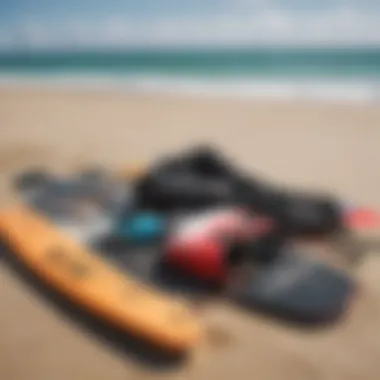

- Starting and Stopping: Every kite surfer must know how to start and stop efficiently. This includes managing the kite's power by adjusting the bar and learning how to edge the board against the pull.
- Riding Upwind: A staple in kite surfing, mastering upwind riding maximizes your range and keeps you in preferred zones longer. It requires coordinating the kite's position while balancing weight on the board.
- Turning: Making smooth transitions, or turns, adds style and fluidity to your ride. Gaining proficiency in heel-side and toe-side turns opens up a new world of maneuverability.
These maneuvers may seem elementary, but they are foundational to progressing in kite surfing. As they say, "You gotta crawl before you walk."
Advanced Tricks and Their Execution
Once the basics are well under control, many riders seek to take it a notch higher by exploring advanced tricks. These may include jumping, spinning, or even flips, which provide an exhilarating experience. However, these require not only skill but also understanding of timing and board control.
- Jumping: The thrill of catching air is one of the sport's defining characteristics. To execute a jump, it's essential to build speed, generate power through the kite, and time the take-off perfectly.
- Spinning: Combining spins with jumps creates visually stunning tricks. A common trick is the handle pass, where the rider transfers the control bar from one hand to another mid-air. This requires immense body awareness and practice.
- Flips: Performing a flip or rotation adds style to jumps. Tricks like the "backroll" or "front roll" necessitate practicing both the jump and the rotational move at the right moment.
Engaging in advanced tricks not only emphasizes skill but also elevates the overall experience of kite surfing. However, attempting these moves without properly mastering foundational skills can lead to accidents, thus careful progression is advised.
Balance and Control Enhancements
The essence of kite surfing lies in the ability to balance and control both the kite and board simultaneously. The better a rider can maintain their balance, the more fluid their surfing will be.
- Body Position: A low center of gravity improves stability. Riders should bend their knees and keep their body aligned with the board to help maintain balance, especially during rapid maneuvers.
- Kite Positioning: Adjusting the kite's position in the wind window dramatically affects lift and power. Higher kite positions yield more height in jumps, while lower positions can help with controlled landings and turning.
- Practice Makes Perfect: Regularly practicing balance exercises on land or water can significantly improve performance. Consider trying one-legged stands or board riding without the kite for better core strength.
While the journey through techniques might be challenging, it’s part of the glorious process of becoming a skilled kite surfer.
"A smooth sea never made a skilled sailor." Understanding and refining these techniques makes all the difference in kite surfing. It’s a blend of art and science that evolves with practice.
Safety Measures and Guidelines
In the exhilarating world of kite surfing, safety is paramount. Every wave you ride or wind gust you embrace can bring joy or pose risks. Understanding the key safety measures not only ensures your well-being but also enhances your overall kite surfing experience. Adhering to these guidelines fosters a culture of respect and responsibility among enthusiasts, making the sport more enjoyable for everyone.
Understanding Risk Factors
Recognizing risk factors is the first step in kite surfing safety. Conditions can change rapidly, and every kite surfer should be mindful of the following:
- Weather Changes: Sudden storms or wind shifts can turn an idyllic day into a hazardous one. Always check the local forecast before heading out.
- Obstacles: Beaches often have hidden dangers, including rocks, coral reefs, or other watercraft. Familiarizing oneself with the area is crucial.
- Crowded Waters: Too many kite surfers in one spot can cause collisions. Spacing out reduces the likelihood of accidents.
Understanding these risks allows a kite surfer to make informed decisions, which is half the battle in ensuring safety on the water.
Emergency Protocols
Preparation for the unexpected can make all the difference. Here’s a framework of emergency protocols every kite surfer should keep in mind:
- Know Your Escape Routes: Before you hit the water, be aware of where you can safely retreata in case of an emergency. Identifying nearby shores can save crucial minutes.
- Communication Devices: Carry a waterproof mobile phone or VHF radio. In case of emergencies, having a reliable means to call for help is invaluable.
- Buddy System: Never kite surf alone if possible. Having someone nearby ensures that help is readily available if needed.
- First Aid Kit: Familiarize yourself with basic first aid procedures and keep a small kit handy. It can be a lifesaver for minor injuries.
Being prepared makes handling emergencies less overwhelming; it counts to remain calm and focused when chaos arises.
Local Regulations and Etiquette
Every kite surfer should adhere to local regulations and community etiquette to promote a safe and enjoyable environment. Here are some protocols to follow:
- Respect Zones: Certain areas may be designated for swimming, surfing, or other activities. Respecting these zones helps prevent accidents.
- Wind Direction Awareness: Always launch and land with the wind at your back to avoid control issues and minimize risk.
- Communication: Use hand signals to indicate your moves to others on the water. This helps everyone understand intentions and reduces collision risks.
- Clean Up Your Gear: Maintain the environment by cleaning up after your session. Leaving a tidy area not only helps the local ecosystem but also builds positive rapport with others.
Following these practices creates a culture of safety and promotes respect within the kite surfing community, resulting in a better experience for everyone involved.
Kite surfing should be a blend of excitement and safety. By understanding risk factors, preparing for emergencies, and adhering to local regulations, you'll further enjoy the electrifying world of kite surfing in Hawaii.
The Cultural Significance of Kite Surfing in Hawaii
Kite surfing isn't just a sport in Hawaii; it embodies the spirit of the islands, interweaving the landscape and cultural richness with the thrill of riding the waves. This energetic watersport has evolved into an integral part of local identity, reflecting both the natural beauty of Hawaii and the deeply rooted traditions of the communities that reside there. Understanding its cultural significance means grasping the shared experiences, camaraderie, and mutual respect that kite surfers foster amidst the stunning backdrops of the Hawaiian archipelago.
Historical Context
Kite surfing in Hawaii has its roots that stretch back across generations. The origins lie not in surf or kite as modern enthusiasts may envision, but rather in the ancient practices of the Polynesians. They utilized sails and kite-like structures to navigate vast ocean distances, showing an early understanding of wind and water.
As time rolled on, the advent of modern kite surfing found its path through the enthusiasm of local surfers seeking alternative ways to harness Hawaiian winds. From the beaches of Oahu to Maui, the sport gained popularity in the late 20th century, eventually becoming a fixture at various local events. This accumulation of history is what gives kite surfing in Hawaii its unique flavor — a blend of ancestral respect and contemporary thrill-seeking.
Contemporary Perspectives
Today, kite surfing in Hawaii symbolizes more than just a recreational pursuit; it acts as a bridge between generations. For locals, it preserves a legacy while adapting to modern advancements. The respect for the ocean and natural forces remains paramount.
Moreover, there’s a palpable shift in how the sport is perceived within and outside the local community. It's seen as a means of enhancing physical and mental well-being. Hence, many enthusiasts practice the sport not just as individuals but as a community, fostering connections that are deeper than the waves they ride. Recreational kiteboarding schools and community organizations have sprouted, encouraging a mindful appreciation of Hawaiian culture through experiential learning.
Influence on Local Community
Kite surfing has undeniably influenced Hawaii’s local economy and social fabric. The influx of enthusiasts brings business opportunities — from gear rentals in spots like Kite Beach to tour guides sharing their knowledge of local wind conditions. This symbiotic relationship enhances the economic landscape without overshadowing the artistic and cultural dimensions unique to Hawaii.
Additionally, kite surfing fosters environmental stewardship among practitioners. Local organizations often unite in efforts to preserve beaches and marine ecosystems. Engaging in friendly community competitions or workshops becomes an avenue to promote eco-conscious behaviors, ensuring that the beauty of the Hawaiian coasts endures for future kite surfers.
Kite surfing not only connects people with nature but also binds them to each other, forming a vibrant tapestry of experiences that celebrates both sport and culture.
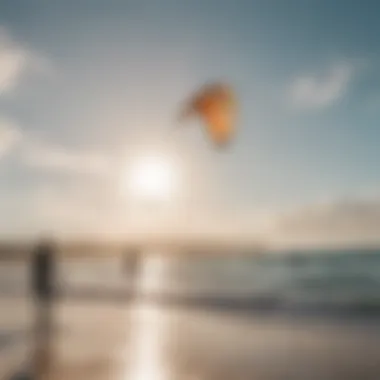

In sum, kite surfing in Hawaii is layered with meaning that transcends just being a pastime. It embraces history, unity, respect for the land and sea, and a passion for adventure. The cultural significance of kite surfing continues to evolve, driving connection for kiteboarders, instructors, and adventurers alike, all striving to appreciate the sacred waters while savoring the thrill of the sport.
Participating in Kite Surfing Competitions
Kite surfing competitions are not just thrilling spectacles; they serve multiple purposes for the community. They foster a spirit of camaraderie and growth amongst both novice and seasoned riders. Engaging in these events elevates the sport, showcases talent, and often motivates gear innovations that can enhance performance. Therefore, understanding the landscape of local competitions becomes vital for anyone looking to dive deeper into kite surfing’s vibrant culture.
Overview of Local Competitions
In Hawaii, nail-biting and breathtaking kite surfing competitions are held regularly across several locations. These events attract participants from all skill levels, infusing the local beaches with excitement and energy. For instance, competitions in Maui's Kite Beach often feature both freestyle and race formats, catering to diverse skill sets.
- Windward Invitational, a signature event, draws top contenders and has a reputation for stellar wind conditions.
- Kona Kite Challenge provides an informal yet exhilarating competition, often seen as a stepping stone for newcomers.
- Oahu Kite Festival combines competition with community, offering workshops and demos alongside the contest.
These competitions not only highlight individual talents but also set the stage for local legends to emerge.
Preparing for Events
Preparation is the key to success in kite surfing competitions, and the approach often varies based on experience levels. For beginners, familiarizing oneself with the competition rules and layouts is crucial. This can include understanding the judging criteria as well as logistics like registration deadlines and equipment checks.
Here are a few preparatory steps:
- Research the Event: Know what to expect. Each event will have its own unique format and judging criteria.
- Gear Check: Ensure your kite, board, and safety equipment are in top shape. Familiarize yourself with your gear's performance in various conditions.
- Practice: Hone your skills in the lead-up. It's not just about prowess in the water but also developing consistent tricks and maneuvers that can impress the judges.
- Mental Preparation: Visualize your performance and go over scenarios in your head. Confidence is half the battle.
What to Expect as a Competitor
Competitions can be as nerve-racking as they are exhilarating. Once you're on the water, expect to experience a flurry of emotions. From the thrill of the crowd's cheers to the intense focus required, it's a unique amalgamation of adrenaline and skill.
Competitors face a structured environment, which might include the following:
- Heats: Riders are often split into heats, where they'll have a set time to showcase their skills.
- Judging: Expect constructive feedback from judges. Understanding how they score can be immensely helpful for future contests.
- Community: Aside from individual performances, you’ll find a supportive atmosphere. Many riders share tips or motivational words which adds to the camaraderie of the sport.
"Participating in kite surfing competitions can expand your skills and deepen your connections within the kiteboarding community."
As one builds their competitive journey, gaining insights from each event becomes just as important as the scores themselves. The knowledge accrued, whether it be conquering nervousness or perfecting maneuvers, truly cements the experience and enhances one’s growth as a rider.
Building a Community Around Kite Surfing
Kite surfing is more than just a sport; it's a vibrant way of life that thrives on shared experiences and personal connections. In Hawaii, the community surrounding kite surfing is as dynamic as the waves themselves. Building a strong community allows kite surfers to exchange tips, celebrate achievements, and address challenges together, enriching the overall experience of this exhilarating activity.
Local Camps and Workshops
Participating in local camps and workshops can immensely benefit both novice and seasoned kite surfers. These gatherings provide a fantastic opportunity for individuals to hone their skills while having fun in a supportive environment. Often organized by local schools, these sessions cover various aspects of kite surfing, such as safety protocols, equipment handling, and advanced maneuvers.
Several camps, like the ones on Maui or Oahu, cater to surfers of all skill levels. Attendees can receive personalized coaching from experienced instructors and can often try out different equipment. It’s also common to meet fellow enthusiasts who share similar passions and interests. This inclusive atmosphere fosters camaraderie, encouraging surfers to motivate one another.
"The friendships you form at these workshops can last a lifetime. Kite surfing creates bonds that go beyond the water."
Online Forums and Social Media Groups
In today's digital age, online platforms play a crucial role in the kite surfing community. Social media groups and forums serve as virtual hubs where enthusiasts from around the globe can exchange knowledge and updates about kite surfing in Hawaii. Websites like Reddit and dedicated Facebook groups allow users to share advice, post questions, and discuss their latest adventures.
Considered one of the best ways to stay in the loop, these online communities also help surfers learn about local events, hidden kite spots, and even gear recommendations. Many experienced kite surfers regularly contribute, providing invaluable insights to newcomers. Being part of these online communities fosters a sense of belonging and encourages surfers to participate in local events and competitions.
Sharing Experiences and Knowledge
Sharing experiences and knowledge is the glue that holds the kite surfing community together. Whether through informal meet-ups by the beach or organized events, storytelling holds immense value. Seasoned surfers often share triumphs and trials, offering wisdom that benefits everyone.
Furthermore, local kite surfing competitions offer a platform for participants to showcase their skills, celebrate their dedication, and learn from each other. Competitions can vary—some are intense, while others are more relaxed and focused on fun. Regardless of the competition level, these events create a sense of excitement and inclusiveness.
Engaging in discussions about techniques, equipment, and spots helps build a supportive environment essential for growth in the sport. By participating in community initiatives and sharing knowledge, kite surfers contribute to a culture that thrives on learning and mutual support, ultimately strengthening the enjoyment of kite surfing in Hawaii.
End and Future of Kite Surfing in Hawaii
As we float toward the conclusion of this exploration into kite surfing, it becomes clear that this sport embodies a unique fusion of adventure and harmony with nature. The discussion surrounding the future of kite surfing in Hawaii is more than just a summation of facts; it reflects the vitality and interconnectedness of the sport with the local environment and the global community of enthusiasts.
Sustaining the Activity in Changing Environments
The crux of continuing the kite surfing tradition in Hawaii rests on our ability to adapt to the rapidly changing environmental conditions. Climate change, as we well know, is not just a distant concern; it translates into shifting wind patterns and rising sea levels. Acknowledging this reality means actively seeking sustainable methods to preserve kite surfing spots. Some potential strategies for sustainability could include:
- Community Monitoring: Local kite surfers must advocate for the preservation of beaches and reefs. By keeping tabs on environmental changes, communities can respond proactively.
- Eco-conscious Gear: Choosing equipment that’s environmentally responsible helps to lessen the sport's overall footprint. Lightweight and biodegradable materials can make a significant difference.
- Education Programs: Workshops focusing on sustainable practices can empower kite surfers to make choices beneficial to marine ecosystems.
Emerging Trends in Kite Surfing
The kite surfing realm continues to evolve, embracing new trends that redefine the sport and its community. One significant trend is the increasing popularity of foil boarding, which involves using a foiled board to glide above the water’s surface. This development not only enhances the riding experience but also opens up new spots, allowing enthusiasts to surf in conditions that were previously deemed unsuitable. Other noteworthy trends include:
- Hybrid Sports Influence: The convergence of kite surfing with disciplines like wing foiling is giving rise to exciting innovations and challenges.
- Adventure Travel: Many kite surfers are now viewing their sport as a gateway to adventure tourism, traveling to lesser-known beaches around the world to discover uncharted kite surfing territories.
- Increased Accessibility: Advances in equipment technology have made kite surfing more accessible to the masses. This shift expands the community and inspires more people to join the fun.
Advocacy for Sustainable Practices
As we look ahead, advocating for sustainable practices is paramount in ensuring kite surfing thrives on Hawaii's shores. This means not just enjoying the beautiful landscapes but also taking part in the responsibility of protecting them. Engaging in local initiatives and partnering with environmental organizations can help reinforce this commitment. Consider the following:
- Participating in Cleanups: Getting involved in beach cleanups not only beautifies the environment but raises awareness about the impact of littering on aquatic ecosystems.
- Collaborating with Local Groups: Aligning with Hawaiian environmental groups can amplify advocacy efforts and engender a culture of environmental stewardship within the kite surfing community.
- Promoting Awareness: Sharing experiences and knowledge about sustainable practices can inspire both new kite surfers and veterans to make conscious choices, creating a ripple effect that benefits the wider community.
The future of kite surfing in Hawaii hinges on our collective actions today. Engaging in sustainable practices ensures that future generations can enjoy the thrill of riding the wind and waves.





